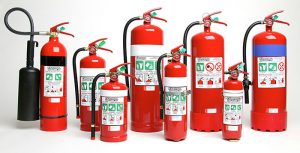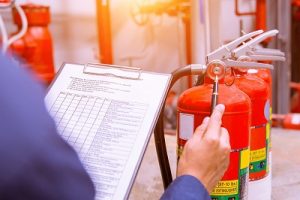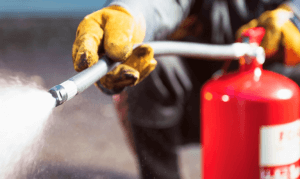The Importance of Fire Safety in the Workplace

As employers and business owners know, the safety of your staff and anyone that enters your work premises should be your number one priority. Which is why, when it comes to fire safety, it’s imperative that your employees know exactly what to do in an emergency.
A fire risk assessment is also a legal workplace requirement as part of the Regulatory Reform (Fire Safety) Order 2005. This assessment, which needs to be carried out by a responsible person, will seek to highlight any fire risks and how these can be reduced as well as pinpointing those people more at risk from a fire. Measures can then be taken to reduce any fire risks to improve workplace safety.
Fire Safety Training for Employees
If a fire does occur in the workplace, good fire practice states that everyone in that building should be guided out that building as quickly and as calmly as possible. However, without adequate fire safety training, it’s likely that people will panic in the event of a fire and be unsure what to do. Meaning there will be a far greater chance of injury or even death.
To help prevent panic, a fire management plan should be put in place. This should make clear the evacuation process you have in place as well as clear signage showing the nearest fire exits to get out of the building as quickly as possible.
You should also conduct regular fire practice sessions where employees can put a fire plan into action. The idea being, the more you practice an evacuation, the more it will feel like second nature if a real fire ever occurred. You can also conduct specialised training, which will help employees know how to deal with certain small fires, stopping them before they become unmanageable.
I work with my clients putting together a fire plan for the building including fire drill procedures, roll call, escape options, key people duties and we practise this on a regular basis.
Your Legal Fire Management Duties

When you’re an employer, it means you have a legal requirement to reduce the chance of fire or injury from fire in that workplace. Which will include carrying out fire assessments to identify hazards and identifying vulnerable people.
When you have 5 or more employees, there is also a legal requirement for you to keep records of anything you find.
A fire risk assessment is needed and the staff must be trained in its contents. This will include a named responsible person, records of your fire training, any precautions taken and a list of people who could be more susceptible to smoke fumes or maybe disabled persons (i.e. those with breathing difficulties).
Common Workplace Fire Hazards
When dealing with fire contingency planning, it’s useful to know common areas or items than can could be a fire hazard. As preventing a fire is always the best form of defence when looking to protect your employees and your business.
Although it is important to remember that fires can occur no matter how careful you are, so you should make sure your staff are trained properly in your building’s evacuation plan. Here are some common fire hazards:
- Areas where combustible materials are kept, such as a cleaning cupboard or stock room.
- Places where a lot of electrical equipment is kept, especially when this equipment is not maintained properly.
- Areas or times where employees are working alone, where it can be difficult to be alerted to a fire or danger.
- Places open to the public or that have poor security measures, as this could be a prime place for arson or accidental fires.
- Areas where there is equipment that uses heat, i.e. kitchen or production areas.
- Generally poor housekeeping.
It is always a great idea to carry out open and close checks to ensure work areas are free from the dumping of paper and waste products and to ensure fire doors are kept clear etc.
Essential Equipment for Fire Management and Workplace Safety

Although most of us will never actually have to deal with a fire in the workplace, it is still essential that you have contingency planning in place. As this will help keep everyone safe if the worst does occur.
- Fire Detectors and Alarms
In order to alert employees quickly to a potential fire – so that evacuation can be put into action – you will need appropriate fire alarms and detectors. These will need to be put throughout your workplace and will need to be checked on a regular basis. - Fire Extinguishers
If a small fire breaks out, it might be possible for trained employees to use a fire extinguisher to put these fires out before they become too big and cause a lot of damage. You will need to ensure that you have an appropriate fire extinguisher for your particular workplace and these will also need to be checked and replaced over time. - Signage for Escape Routes
Although your employer will be conducting regular fire safety training and practice, it’s still important that you have signage across the workplace. Not only will this remind staff who will be feeling under pressure, it will also help any visitors to get out the building quickly.
You will also want to have signs indicating the regular day and time that you run fire alarm tests. Otherwise visitors may become alarmed unnecessarily. - Fire Doors
There should be fire doors throughout your building, where these heavy doors will work to stop the spread of fire. Like other fire safety equipment, these doors will need to be maintained and checked on a regular basis.
A workplace fire might not be something that we’d expect to happen, yet it’s incredibly important that you have a fire contingency plan in place. Not only is fire training a legal requirement of a business, it’s an essential practice to keep your employees, your stock and your buildings safe too. - Fire blankets
Should be kept in the kitchen areas ready for use and checked on a regular basis. Training should be carried out on the use. The dates need to be checked as these do go out of date. - Emergency Lighting
These should be in your work areas and checked on a regular basis by a competent contractor. They should be marked on your fire plan.
Training
Fire Safety training is so vital to your business, that it makes sense to invest in professional training for your employees. That way, you’ll feel safe in the knowledge that your team are the best equipped to deal with a fire if the worst happens. Regular sessions should be carried out with all staff along with regular documented fire drills.


